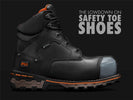
The Lowdown on Safety Toe Shoes: Steel vs Composite Toe
, by Ed Stone, 7 min reading time

, by Ed Stone, 7 min reading time
Chances are, if you’re required to wear safety toe shoes at work, you already know a thing or two about safety footwear. In fact, your employer probably has a strict safety requirement about what type of footwear you can and can’t wear on the job. These standards are pretty common practice when it comes to job safety.
What you might not know are the differences between safety toe footwear and which shoes are the best choice for your particular work conditions. Never fear, our footwear experts are here to point you in the right direction!
In this post, we’ll explain the differences between steel toe safety shoes, composite toe safety shoes, and alloy toe safety shoes—and bust some general myths about safety toes.

Safety-toe footwear helps protect your toes from being either pierced or crushed while on the job. A safety toe box is placed inside the toe area of the shoe to provide foot protection. This protective footwear is designed to ASTM standards to protect against impact and compression.
Many people question, does "safety toe" mean "steel toe"? While they can be used interchangeably, it does not mean that all safety toe shoes have a steel toe. As of now, there are two main types of safety toe shoes: steel toe shoes and composite toe shoes, not to mention alloy toe shoes.
Built with heavy-duty steel toes for maximum toe protection. Steel-toe shoes are the time-tested standard in safety footwear. Some industries or job sites mandate steel toe protection to meet OSHA or other regulatory standards—so be sure to check with your supervisor before heading to work. We especially recommend steel-toe shoes for the following scenarios:

Built from non-metal composite materials that usually include some combination of carbon fiber, Kevlar, plastic, and/or fiberglass. The non-metal design of composite toes makes them ideal for certain working conditions. While composite safety toe shoes are an excellent and popular option, composite toes could be compromised if they receive a direct, significant impact (resulting in fractures in the toe box composition) and should therefore be replaced. We particularly recommend composite toe shoes for:

Alloy Toe Shoes are a lightweight, light-duty configuration of different kinds of metals. They tend to be pricier, and there aren’t as many on the market, but they meet ASTM safety standards just like steel toes and composite toes.

Wearing steel toes could cause your toes to get cut off from an impact. While steel toes help protect your toes from injuries, they’re not always enough to prevent injuries in extreme circumstances. But the fact remains that steel toes do much more good than harm. In his 49+ years of working in safety footwear, Boot World President Ed Stone cannot recall anyone with a negative experience wearing a steel-toe shoe that was fitted properly. In fact, he’s had countless customers share that a steel safety toe shoe saved their toes during an accident. Need more proof? MythBusters did a whole episode testing steel toes. Their conclusion: “You will always have more damage to your feet if you’re not wearing steel tips than if you’re wearing them.” The bottom line is, injuries sustained while wearing steel toes are not caused by the steel toes—and in most cases, steel toes help lessen the severity of the injury.
Steel toe shoes are heavier than composite safety toe shoes. This isn’t necessarily the case. The weight of a safety shoe depends on the construction and materials of the entire shoe, not just the safety toe box. So, depending on how a steel toe shoe is constructed compared to a composite toe shoe, the steel toe shoe may be lighter. Weight comes down to the protective footwear, not the safety toe material.

Steel toes aren’t safe for electricians or people working around live wires. When it comes to electricity, steel toes are just as safe as composite toes. The only thing that protects you from electrocution or shock are the insulating properties of components on the bottom of certain shoes that disrupt the flow of electricity through the shoe into the ground (thus reducing the likelihood of electrocution or shock). This is why EH (electrical hazard) shoes were invented. We’ll get into EH shoes more in another post, but if you’re looking for protection from electrocution or shock, choose a shoe with the ASTM EH label on it.
Steel toes work just as well as composite toes in extreme weather: Composite toes are the clear winner when it comes to harsh weather conditions—both cold and hot. Since they’re not made of metal, composite toes don’t conduct temperature as efficiently as steel toes do. This means that composite toe boots will insulate your feet better from extreme cold or extreme heat, whereas steel toes will absorb that temperature into the shoe, thus causing more discomfort to your feet.
Conclusion: Don’t let myths steer you wrong—modern safety toe footwear is designed to meet rigorous ASTM standards and provide reliable protection. Whether you're working around heavy machinery, in extreme weather, or passing through metal detectors, there's a safety toe shoe built for your needs.
Ed Stone brings over 45 years of footwear knowledge and passion to his role as President of Boot World, a family-owned company and an industry leader in safety and occupational footwear. A second-generation "shoe dog," Ed's footwear knowledge is unparalleled, serving as an informal advisor for some of the world's largest footwear brands, including Wolverine, Timberland PRO, and Reebok Works. A lifelong Southern California resident and ardent conservationist, Ed enjoys hiking and open water swimming.